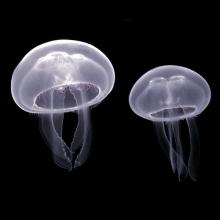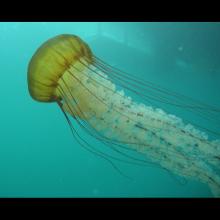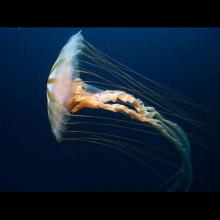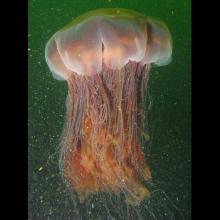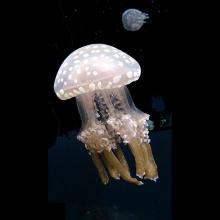Aurelia aurita
Common name:
Common jellyfish
Order:
Semaeostomeae
Class:
Scyphozoa
Subphylum:
Medusozoa
Chrysaora fuscescens
Common name:
Pacific sea nettle
Order:
Semaeostomeae
Class:
Scyphozoa
Subphylum:
Medusozoa
Chrysaora melanaster
Common name:
Brown sea nettle
Order:
Semaeostomeae
Class:
Scyphozoa
Subphylum:
Medusozoa
Cyanea capillata
Common name:
Lion's mane jellyfish
Order:
Semaeostomeae
Class:
Scyphozoa
Subphylum:
Medusozoa
Phyllorhiza punctata
Common name:
White spotted jellyfish
Order:
Rhizostomeae
Class:
Scyphozoa
Subphylum:
Medusozoa
Aurelia aurita
Common name:
Common jellyfish
Order:
Semaeostomeae
Class:
Scyphozoa
Subphylum:
Medusozoa
Chrysaora fuscescens
Common name:
Pacific sea nettle
Order:
Semaeostomeae
Class:
Scyphozoa
Subphylum:
Medusozoa
Chrysaora melanaster
Common name:
Brown sea nettle
Order:
Semaeostomeae
Class:
Scyphozoa
Subphylum:
Medusozoa
Cyanea capillata
Common name:
Lion's mane jellyfish
Order:
Semaeostomeae
Class:
Scyphozoa
Subphylum:
Medusozoa
Phyllorhiza punctata
Common name:
White spotted jellyfish
Order:
Rhizostomeae
Class:
Scyphozoa
Subphylum:
Medusozoa
Aurelia aurita
Common name:
Common jellyfish
Order:
Semaeostomeae
Class:
Scyphozoa
Subphylum:
Medusozoa
Chrysaora fuscescens
Common name:
Pacific sea nettle
Order:
Semaeostomeae
Class:
Scyphozoa
Subphylum:
Medusozoa
Chrysaora melanaster
Common name:
Brown sea nettle
Order:
Semaeostomeae
Class:
Scyphozoa
Subphylum:
Medusozoa
Cyanea capillata
Common name:
Lion's mane jellyfish
Order:
Semaeostomeae
Class:
Scyphozoa
Subphylum:
Medusozoa
Phyllorhiza punctata
Common name:
White spotted jellyfish
Order:
Rhizostomeae
Class:
Scyphozoa
Subphylum:
Medusozoa
Class (Animalia): Scyphozoa
The Scyphozoa are an exclusively marine class of the phylum Cnidaria, referred to as the true jellyfish (or "true jellies"). It may include the extinct fossil group the Conulariida, whose affinities are uncertain and widely debated.
The class name Scyphozoa comes from the Greek word skyphos (σκύφος), denoting a kind of drinking cup and alluding to the cup shape of the organism.
Scyphozoans have existed from the earliest Cambrian to the present.
Biology
Most species of Scyphozoa have two life-history phases, including the planktonic medusa or jellyfish form, which is most evident in the warm summer months, and an inconspicuous, but longer-lived, bottom-dwelling polyp, which seasonally gives rise to new medusae. Most of the large, often colorful, and conspicuous jellyfish found in coastal waters throughout the world are Scyphozoa. They typically range from 2 to 40 cm (1 to 15 1⁄2 in) in diameter, but the largest species, Cyanea capillata can reach 2 meters (6 ft 7 in) across. Scyphomedusae are found throughout the world's oceans, from the surface to great depths; no Scyphozoa occur in freshwater (or on land).
As medusae, they eat a variety of crustaceans and fish, which they capture using stinging cells called nematocysts. The nematocysts are located throughout the tentacles that radiate downward from the edge of the umbrella dome, and also cover the four or eight oral arms that hang down from the central mouth. Some species, however, are instead filter feeders, using their tentacles to strain plankton from the water.
Reference: Wikipedia

